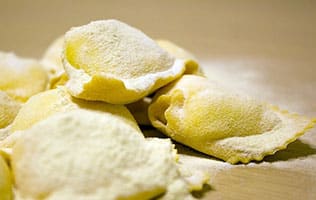 The notion of ravioli comes from the Italian word raviolo , which refers to a small square of filled pasta . A ravioli , ravioli or raviole , therefore, is a pasta made with flour that is filled with vegetables , meat , ricotta ( cottage cheese ) or another ingredient.
The notion of ravioli comes from the Italian word raviolo , which refers to a small square of filled pasta . A ravioli , ravioli or raviole , therefore, is a pasta made with flour that is filled with vegetables , meat , ricotta ( cottage cheese ) or another ingredient.
Ravioli or ravioli are a very popular food in many regions. They are usually served with cream or some sauce , tomato sauce being one of the most chosen.
Although for a long time it was held that Marco Polo brought the wonton or jiaozi from China to Europe , leading to the emergence of ravioli as we know them today, today it is believed that ravioli were born in northern Italy many years ago. before.
In South American countries, it is a tradition for families to get together at noon on Sunday and have ravioli for lunch. In this case, custom indicates that ravioli are served accompanied by grated cheese .
To assemble the ravioli, a sheet of dough is laid out and small portions of filling are placed on it. Then the preparation is covered with another sheet of dough, the pasta is closed and the ravioli are cut. Cooking, meanwhile, is done in boiling water .
Although there are numerous regional recipes that are accepted as "official", it is undeniable that variations of different magnitudes can be carried out in each house, to the point that ravioli are not the same even in all parts of the same city. This does not mean that we should not establish certain limits, since ravioli have their own personality, which distinguishes them from other similar preparations, such as añolotis, capeletinis and tortellinis.
First is its appearance: the ravioli are basically square, but their edges must exhibit a series of spikes that are achieved when cutting them. Añolotis, on the other hand, although they can also be square and have similar edges, are usually prepared as small empanadas joined at the front by their two ends. The capeletis have an appearance that makes us think of "small hats" and the tortellinis look like the Añolotis but have their filling distributed almost throughout their body, instead of with a tendency towards the center.
 These characteristics vary in each part of the world, even within Italy, so they serve as mere information to guide you in the kitchen but do not restrict creativity when preparing each type of pasta. The characteristics of the dough and the sensations it produces on the palate are also important, particularly to differentiate ravioli from pizza or bread: the use of egg is the main difference, although its kneading and consistency are also important. For each portion of ravioli, the use of one egg yolk is required.
These characteristics vary in each part of the world, even within Italy, so they serve as mere information to guide you in the kitchen but do not restrict creativity when preparing each type of pasta. The characteristics of the dough and the sensations it produces on the palate are also important, particularly to differentiate ravioli from pizza or bread: the use of egg is the main difference, although its kneading and consistency are also important. For each portion of ravioli, the use of one egg yolk is required.
In vegan homes, since any product of animal origin is dispensed with, it is possible to prepare ravioli simply with vegetable butter instead of egg and the result is equally soft and delicious. The same applies to the filling, where textured soy replaces the meat and can be accompanied with mushrooms of various types, among other delicacies that nature offers us.
It is important to keep in mind that, in several nations, the idea of ravioli to refer to this pasta always appears in the plural : ravioles . In Argentina , in fact, raviol ( singular ) refers to a papelina : a paper package that wraps a small amount of drug .
A ravioli, in this framework, is destined for the retail sale of the narcotic . Thus, a cocaine ravioli is a package of this drug for individual or small group consumption.
